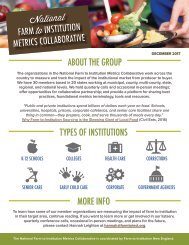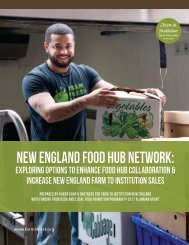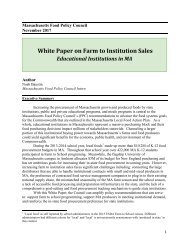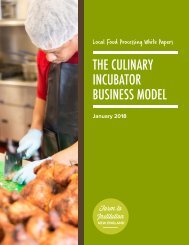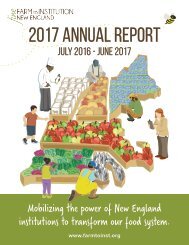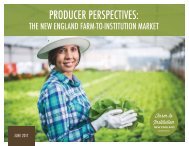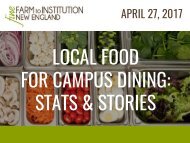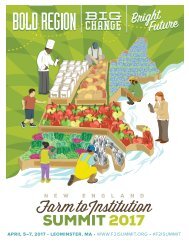FINE Workforce Dev White Paper
Create successful ePaper yourself
Turn your PDF publications into a flip-book with our unique Google optimized e-Paper software.
INTRODUCTION<br />
High Mowing Seeds at the Vermont Food Venture Center<br />
The US food manufacturing sector has been<br />
expanding since the end of the recession. The<br />
number of food manufacturing establishments<br />
has increased by nearly 13% since 2010, and<br />
employment grown by 5%, an addition of<br />
nearly 80,000 jobs (BLS). At the same time,<br />
several national trends are converging that<br />
make finding and retaining the right workforce<br />
for the expansion of food manufacturing<br />
increasingly challenging. First, much of the<br />
work is becoming increasingly technical and<br />
specialized. In the wake of the Food Safety<br />
Modernization Act (signed into law by president Obama in 2011; see companion paper Food Safety<br />
Regulation: An Introduction for Entrepreneurs) a detailed understanding of food safety, recordkeeping,<br />
and process controls have become more important than ever before. Similarly, efficiencies of scale<br />
are continuing to drive automation of many production processes, prompting the need for workers<br />
adept at learning and using new technology. Second, the aging of the baby boomer generation (the<br />
post-war demographic bump of those born between 1946 and 1964) underlies the shift to an older<br />
US workforce. Sometimes dubbed the “silver tsunami” (Schumpeter) this sea change is currently well<br />
under way. According to the Bureau of Labor Statistics, workers 55 years or older made up only 13% of<br />
the US workforce in 2010, but that number is projected to nearly double, to 25% by 2020 (Mitra, p56).<br />
Finally, manufacturers face a decreased pipeline of qualified candidates entering the industry.<br />
Major <strong>Workforce</strong> Pressures Facing the Food Manufacturing Sector<br />
Public colleges, one critical piece of workforce<br />
development infrastructure, illustrate part of the<br />
pipeline challenge: according to the Center on Budget<br />
and Policy Priorities almost all states are spending less<br />
per student than before the recession, typically much<br />
less. Their research found that “the average state<br />
is spending $1,805, or 20 percent, less per student<br />
than it did in the 2007-08 school year” (Mitchell and<br />
Leachman). Not surprisingly, many colleges have<br />
responded by raising tuition: “annual published tuition<br />
at four-year public colleges has risen by $2,068, or<br />
WORKFORCE DEVELOPMENT: A CHALLENGING OPPORTUNITY<br />
3




